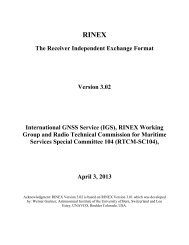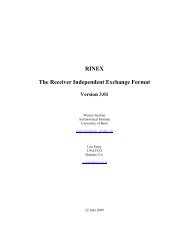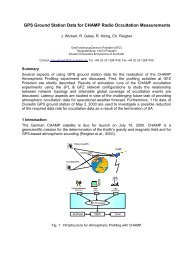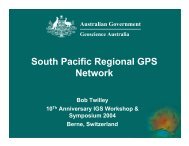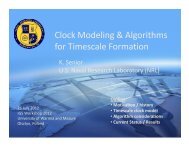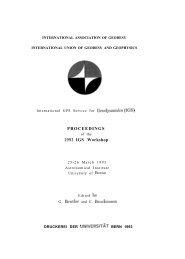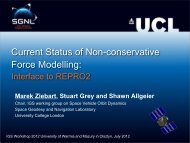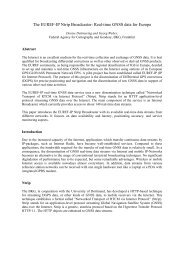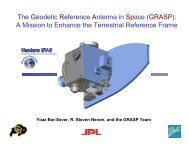IGS Analysis Center Workshop - IGS - NASA
IGS Analysis Center Workshop - IGS - NASA
IGS Analysis Center Workshop - IGS - NASA
You also want an ePaper? Increase the reach of your titles
YUMPU automatically turns print PDFs into web optimized ePapers that Google loves.
International Terrestrial Reference Frame realized by the coordinates and velocities of the<strong>IGS</strong> tracking stations [Blewi?f et al., 1993; Bock el al., 1993]. Fortunately, the <strong>IGS</strong> beganits test campaign several weeks before the Landers earthquake sequence so that the globaltracking network was quite robust. The PGGA results were the first demonstration of subcentimeter-levelcomputation of coseismic displacements with respect to the ITRF anddemonstrated the synergism between regional clusters and the <strong>IGS</strong>.In August 1991, S10 began analyzing data from the PGGA on a daily basis. In order tocompute precise satellite ephemerides, data from the available global tracking stations (pre-<strong>IGS</strong>) were analyzed simultaneously with the PGGA data, Initial solutions of PGGA andglobal data included a manageable number (15-20) of regional and global stations and 15satellites so that the simultaneous analysis of all station data was straightforward. By thetime of the Landers earthquake the total number of stations had increased to 25 with 18satellites, still a manageable number for a simultaneous analysis. Today the <strong>IGS</strong> GlobalData <strong>Center</strong>s archive data from over 50 stations and 25 active GPS satellites. S10 currentlyanalyzes 32-35 stations in a simultaneous adjustment of 24-hour sessions, including bothPGGA and global <strong>IGS</strong> data. With current processing schemes, top-of-the line scientificworkstations and abundant disk space, the daily, simultaneous analysis of 35 stations isstill manageable. However, as the number of stations increases above this number, thecomputation time and disk-space requirements are approaching a critical stage.Considering that we expect the number of PGGA stations to increase by at least fivestations over the next few months and that several useful global stations will come on line,we have begun tests on distributed processing of PGGA and <strong>IGS</strong> data. Initial results fromthese tests are described below.4.3 Distributed <strong>Analysis</strong>: One Approach.Au@ is tools. The PGGA and <strong>IGS</strong> data are currently adjusted simultaneously at S10 inindependent twenty-four hour (0-24h UTC) segments using the GAMIT GPS software[King and Bock, 1993]. A weighted-least squares algorithm is used to produce a series oftightly-constrained and loosely-constrained solutions including the estimation of stationcoordinates, satellite initial conditions, tropospheric zenith-delays and phase ambiguityparameters [e.g., Feigl et al, 1993]. The adjustments and corresponding variancecovariancematrices for the station-coordinate parameters are output from the tightlyconstrainedadjustments in a format suitable for a standard weighted least squares networkadjustment of station coordinates from both ambiguity-free or ambiguity-resolved (biasesfixed)solutions [e.g., Bock et al., 1985; Dong, 1993]. In the loosely-constrainedadjustments (also output for ambiguity-free and ambiguity-fixed solutions), the portion ofthe variance-covariance matrix for station d orbital parameters is recorded in an auxiliaryfile, henceforth referred to as a “solution file.” In this representation, the underlyingterrestrial reference frame is essentially undefined (a free network adjustment), although thephysical models are implicit in the partial derivatives that were used to form the variancecovariancematrices (as is the case, of course, for the tightly constrained adjustments).The solution files can then be manipulated to estimate any combination of station positionsand velocities, orbital elements and earth orientation. This is done with the GLOBKsoftware [Herring, 1993] which uses a Kalman filter formulation [Herring et aL, 1990] tocombine the auxiliary files, with the ability to treat each type of parameter stochastically.This appro~ch allows us the combination and, if necessary, the quick re-analysis of manydaily IGWPGGA solutions (we’ve generated at S10 almost 1000 of these daily solutions)using different terrestrial reference frames and with different station/orbitaUearth orientationconstraints. (Of course, if we would like to modify the underlying physical models thenthe individual, daily GAMIT solutions would need to be repeated, a formidable but not81




